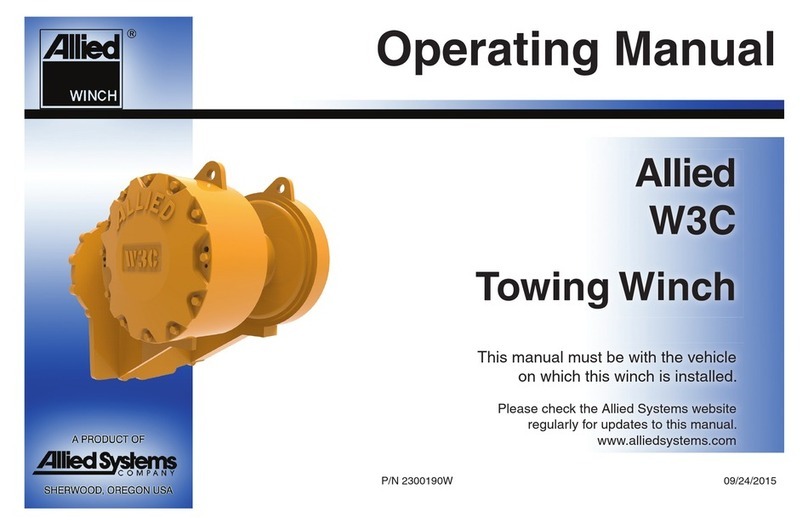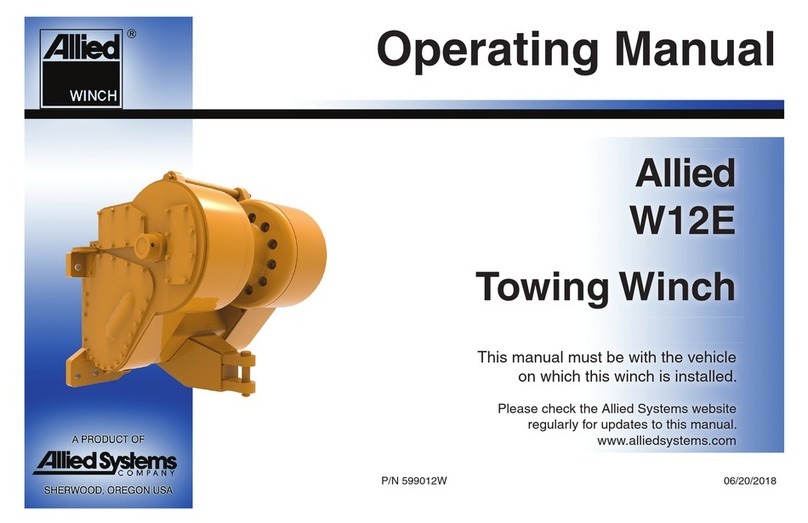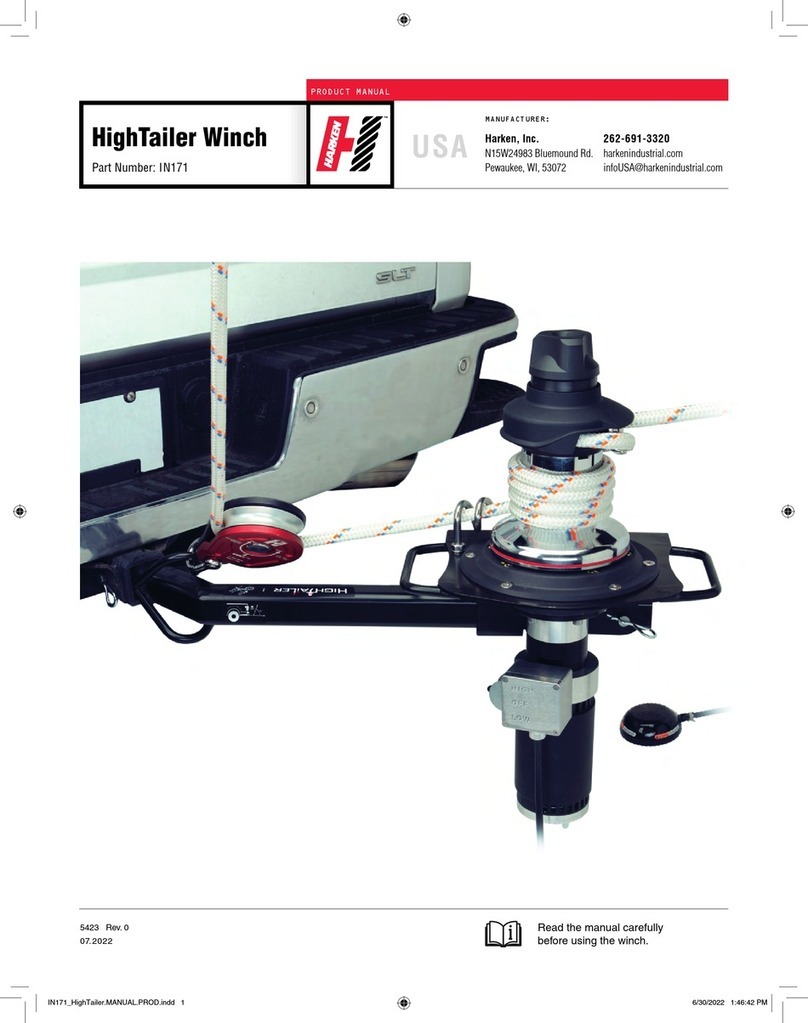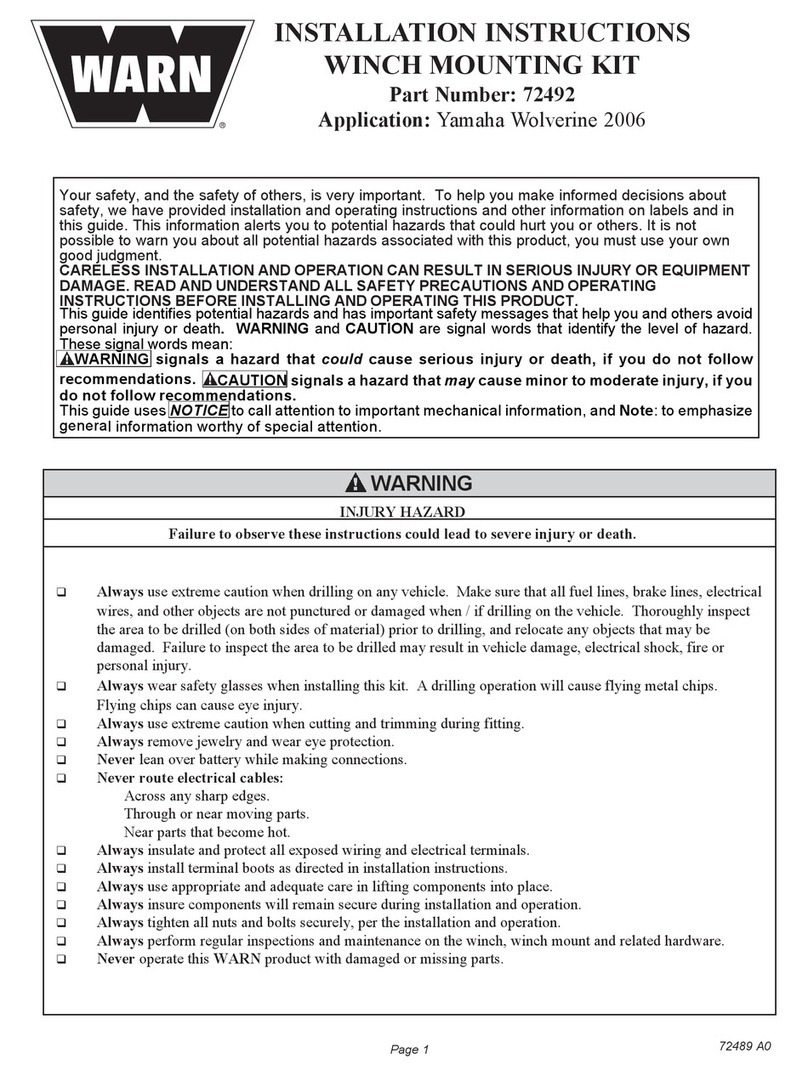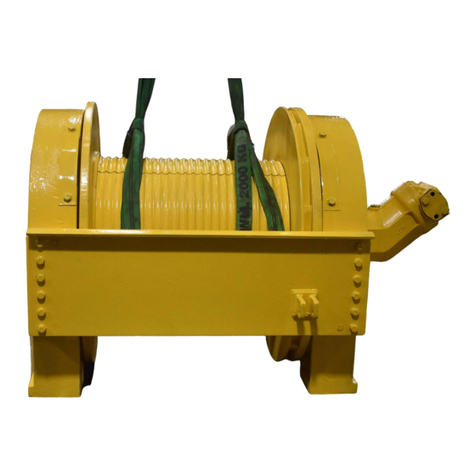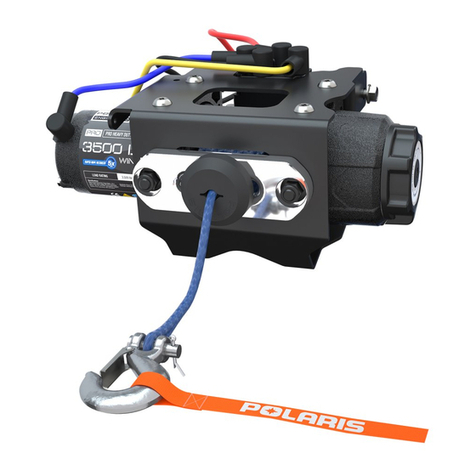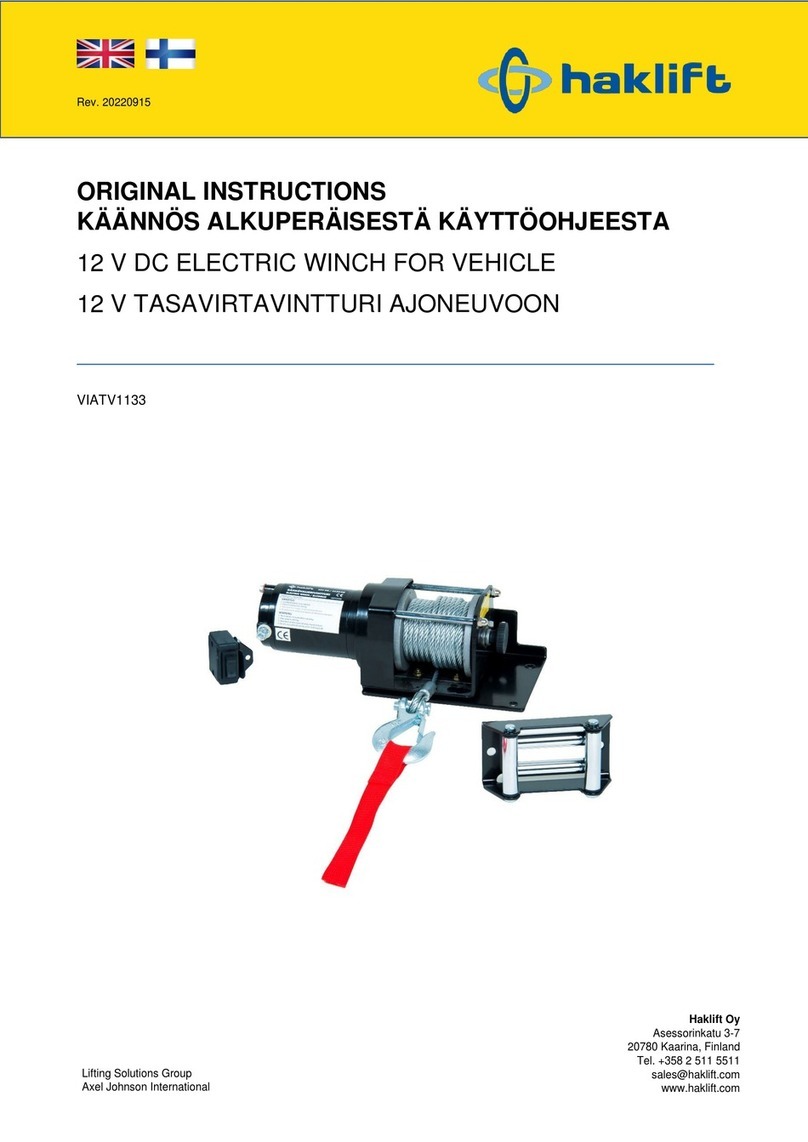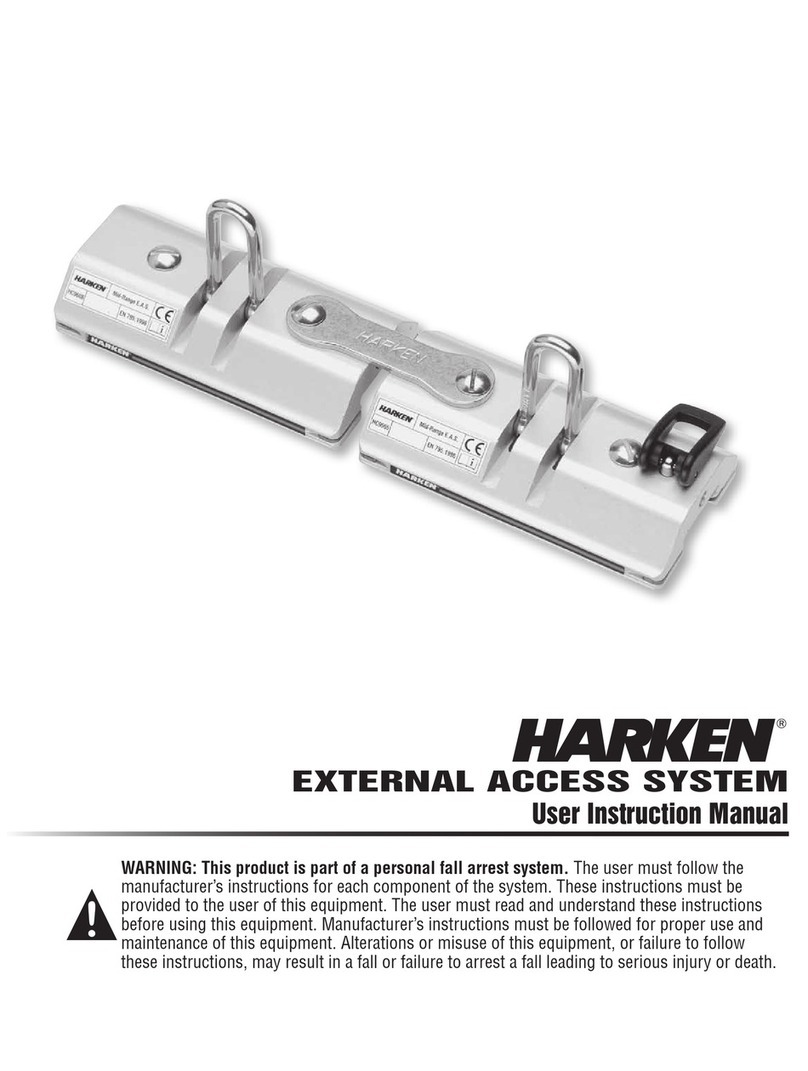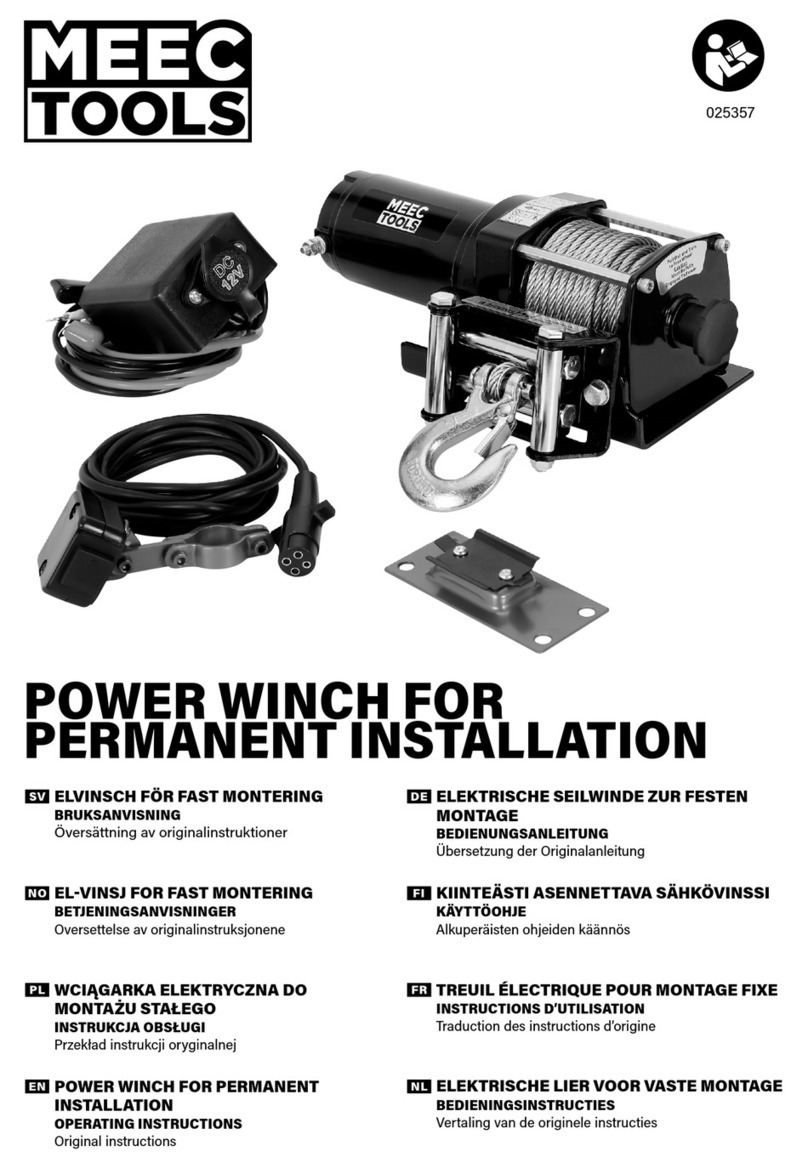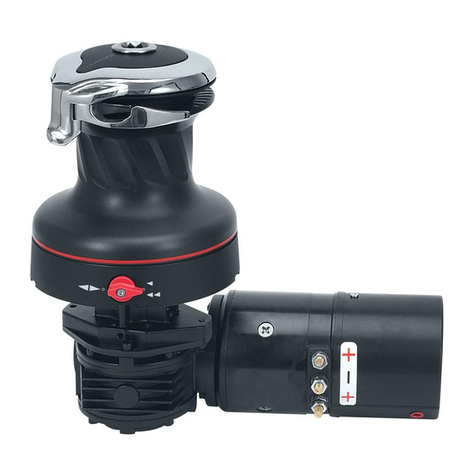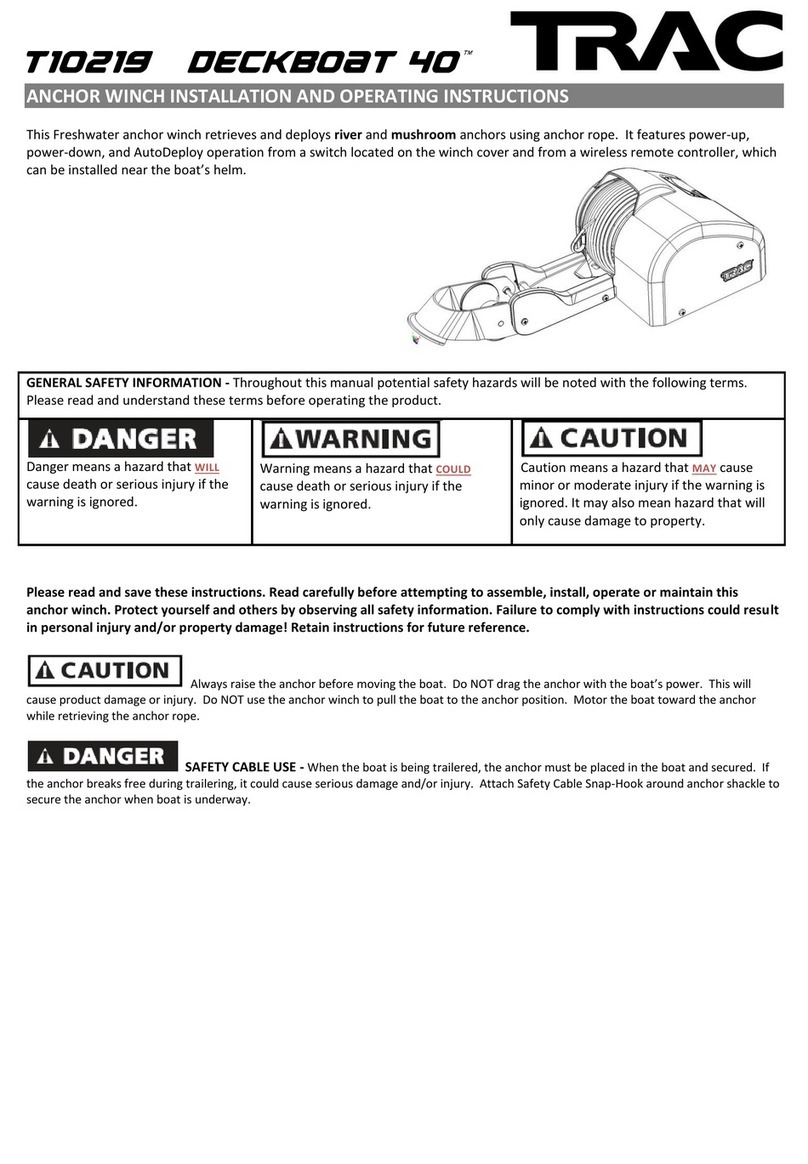Allied Systems H4A User manual

P/N 599014W Printed in U.S.A. 03/05/2021
Hydraulic
Winch
This manual must be with the vehicle
on which this winch is installed.
Please check the Allied Systems website
regularly for updates to this manual.
www.alliedsystems.com
A Product of
Sherwood, OR USA
Operating Manual
H4A
AP d f

03/05/2021
Printed in U.S.A.
A Product of Allied Systems Company
Sherwood, Oregon
U.S.A.
Winch Model H4A
Date Delivered
Serial Number
Date Installed
Special Equipment or Attachments

i
Foreword
The safe and efficient operation of a winch requires skill
and alertness on the part of the operator. To develop the
skills required, the operator must:
• Receive training in the proper operation of the winch
and the machine on which it is mounted.
• Understand the capabilities and limitations of the
winch and the machine on which it is mounted.
• Become familiar with the winch and the machine on
which it is mounted and see that they are maintained
in good condition.
• Read and understand the SAFETY SUMMARY
and OPERATING PROCEDURES contained in this
Operating Manual.
In addition, a qualified person experienced in the operation
of the winch must guide a new operator through several
load handling applications before the new operator
attempts to operate the equipment alone. It is the
employer’s responsibility to make sure that the operator
can see, hear, and has the physical and mental ability to
operate the equipment safely.
This Operating Manual contains basic information
necessary for the operation and maintenance of a winch.
Optional equipment is sometimes installed that can
change the characteristics described in this manual.
Make sure the necessary instructions are available and
understood before operating the winch.
Some of the components described in this Operating
Manual will NOT be installed on your winch. If you have
questions about any item on your winch or described in
this Operating Manual, contact your local winch dealer,
or contact Allied Systems Company:
Allied Systems Company
21433 SW Oregon Street
Sherwood, OR 97140 USA
Phone: 503-625-2560
Fax: 503-625-7269
E-Mail: [email protected]
Also visit our website, www.alliedsystems.com, where
the most current copy of this manual is always available.
Foreword

ii
Note: For repairs and overhaul, contact your
Allied winch dealer. If you maintain your own
equipment, a service manual is available for
your specific winch.
Note: This publication may be translated
to different languages for sole purpose of
easy reference in non-English speaking
locations. Should there be differences in
interpretations to the text, please refer to
the English language edition published by
Allied Systems Company as the controlling
document.

iii
Contents
Foreword ..................................................................i
Contents................................................................. iii
Safety Summary .....................................................v
General
Introduction...............................................................1
Operating Principles of the Winch ............................1
Nameplate ................................................................2
Wire Rope Selection.................................................3
Winch Description.....................................................4
Control Levers & Decals............................................6
Recommended Oil List ...........................................10
Oil Capacity ............................................................10
Serial Number Codes .............................................11
Tractor Identification & Winch Gear Ratios .............12
Optional Equipment................................................14
Operation
Checks Before Operation .......................................15
Warning Lights........................................................15
Operating Procedures ............................................16
BRAKE-ON ......................................................16
LINE-IN ............................................................16
HI-SPEED ........................................................17
LINE-OUT ........................................................17
FREESPOOL ...................................................17
BRAKE-OFF ....................................................17
Operational Adjustments ........................................18
FREESPOOL Drag Adjust ...............................18
Arch Adjustments.............................................18
Maintenance
General...................................................................21
Maintenance Points ................................................22
Maintenance Schedule...........................................23
Troubleshooting ......................................................24
Troubleshooting Chart......................................25
Operating Techniques
Tractor or Skidder Operation ..................................27
How To Move A Disabled Vehicle............................30
Working on A Steep Slope .....................................32
Tractor Is Down The Slope ...............................32
Other Equipment Is Down The Slope...............33
Contents

iv
Intentionally Blank

v
Safety Summary
General Safety Notices
The following pages contain general safety warnings
which supplement specific warnings and cautions
appearing elsewhere in this manual. All electrical and
hydraulic equipment is dangerous. You must thoroughly
review and understand the Safety Summary before
attempting to operate, troubleshoot or service this winch.
The following symbols/terms are used to emphasize safety
precautions and notices in this manual:
DANGER
The “DANGER” symbol indicates a
hazardous situation which, if not avoided,
will result in death or serious injury.
Carefully read the message that follows to
prevent serious injury or death.
WARNING
The “WARNING” symbol appears wherever
incorrect operating procedures or practices
could cause serious injury or death.
Carefully read the message that follows to
prevent serious injury or death.
CAUTION
The “CAUTION” symbol appears where a
hazardous situation which, if not avoided,
could result in minor to moderate injury and
equipment damage.
Safety Summary

vi
NOTICE
This signal word alerts to a situation that is
not related to personal injury but may cause
equipment damage.
NOTE: …
The term “NOTE” highlights operating
procedures or practices that may improve
equipment reliability and/or personnel
performance.
Safety Regulations
Each country has its own safety legislation. It is in the
operator’s own interest to be conversant with these
regulations and to comply with them in full. This also
applies to local bylaws and regulations in force on a
particular worksite.
Should the recommendations in this manual deviate from
those in the user’s country, the national regulations should
be followed.
NOTE: All possible safety hazards cannot
be foreseen so as to be included in this
manual.Therefore, you must always be alert
to potential hazards that could endanger
personnel and/or damage the equipment.
WARNING
The winch shall not be used for hoisting.
WARNING
Use hearing protection when operating
winches.

vii
Safety Summary
• Never inspect, repair, or perform maintenance on a
machine that is in motion.
• Inspect the winch before each use:
»Make sure that the controls and instruments
operate correctly.
»Report the need for repairs immediately.
»Do not work with a damaged or worn wire rope.
»Do not use a winch that needs repairs.
»If the wire rope and ferrule must be removed from
the drum, make sure the end of the wire rope and
ferrule are controlled when the ferrule is released.
The end of the wire rope can suddenly move from
the drum like a compressed spring when the
ferrule is released and cause an injury.
• Stay in the operator’s seat when operating the winch.
• Do not stand on the vehicle when operating the winch.
• Avoid winch operation near people or other machines.
Operation, Inspection, and Maintenance Warnings
Obey the following cautions and
warnings before using your winch to
avoid equipment damage, personal
injury or death.
• Do not operate the winch unless you are authorized
and trained to do so.
• Do not operate the winch unless the vehicle is
equipped with a screen to protect the operator if the
wire rope breaks.
• Read, understand, and follow the operating,
inspection, and maintenance instructions in this
Operating Manual.
• Do not use the control levers for hand holds when
entering or leaving the vehicle.
• Do not permit other people near the control area when
you inspect or repair a machine.

viii
• Never stand nor permit others to stand in the bight
(loop) of a wire rope.
• Do not stand nor permit others to be near the winch
or wire rope when there is tension on the wire rope.
• Observe jobsite rules.
• Be in complete control at all times.
• Do not use the control levers as hangers for clothes,
water bags, grease guns, lunch pails, etc.
• Do not leave the vehicle when the winch wire rope
is under tension.
• Do not permit riders on the vehicle or load.
• Do not use the winch as an anchor for a double or
two-part line.
• Do not pull the hook through the throat or over the
drum, which will cause damage.
• When the winch is not in use, make sure the control
lever is in BRAKE-ON position and the winch brake
is applied.
• Do not use winch as a hoist. Tractor and skidder
mounted winches are designed for towing.
• Always inspect wire rope, tail chain and other rigging
components for wear, damage, broken strands or
abuse before use.
• Never use wire rope, tail chain or other rigging that
is worn-out, damaged or abused.
• Never overload wire rope, tail chain or rigging.

ix
Safety Summary
• Wire rope and tail chain will fail if worn-out,
overloaded, misused, damaged, improperly
maintained or abused. Wire rope or tail chain failure
may cause serious injury or death!
KG
KG
• Do not terminate wire rope to tail chain by the use
of a knot.
• Do not handle wire rope if the hook end is not free.
A load could break away, suddenly tensioning the
wire rope, resulting in serious injury or death.
• Stay clear of wire rope entry areas (fairlead or arch
rollers, winch drum etc).
• Make sure that ground personnel are in plain view of
the operator, and at a distance of at least 1½ times
the working length of the wire rope.
• Make sure that any hand signals used by ground
personnel are clearly defined and understood by
everyone involved.
• Do not attempt to “jerk” or “shock” a load free. Doing
so can cause loads in excess of the rated capacity
of the wire rope, winch, or mounting hardware.
• Replace any parts only with genuine Allied Winch
parts. Refer to parts manual 599015W.
• Maintain a minimum of three (3) complete wraps
of wire rope on the drum for normal operation. It
may help to paint the last five (5) wraps of wire rope
a contrasting color, to serve as a visual indicator.
• Do not handle wire rope with bare hands. Wear
leather gloves at all times.

x
• Align the tractor with the load to prevent side loading
the winch, and to maintain even spooling of the
wire rope.
• If applying tension to the wire rope manually during
spooling:
»ensure that the operator is winching in slowly,
»keep your hands and clothing well clear of any
rollers or the winch drum,
»do not maintain tension by letting the wire rope
to slip through your hands,
»use a hand-over-hand technique to maintain
tension.
• Be aware of the ground conditions, and make sure
the ground and tractor are stable enough to pull
the intended load.
• Do not attempt to pull loads in excess of the rated
capacity of the winch.
• Keep yourself informed of any applicable codes,
regulations and standards for the job.
• Your winch may have temperature shut-off system
for protection of tractor and winch. Manual override
of high temperature shut-off will cause damage to
tractor and winch.
• This winch is neither intended, designed, nor rated
for any application involved in the lifting or moving
of personnel.
• Use only the lubricants listed in the Recommended
Oil List. See Figure 17 on Page 29.
• Do not weld on any part of the winch. Contact Allied
Systems if weld repairs are needed.
• The hydraulic system must be kept clean and free
of contamination at all times.

xi
Safety Summary
• Be aware of the hazards of pressurized hydraulics:
»Wear personal protective equipment, such as
gloves and safety glasses, whenever servicing
or checking a hydraulic system.
»Assume that all hydraulic hoses and components
are pressurized. Relieve all hydraulic pressure
before disconnecting any hydraulic line.
»Never try to stop or check for a hydraulic leak
with any part of your body; use a piece of
cardboard to check for hydraulic leaks.
»Small hydraulic hose leaks are extremely
dangerous, and can inject hydraulic oil under
the skin, even through gloves.
»Infection and gangrene are possible when
hydraulic oil penetrates the skin. See a doctor
immediately to prevent loss of limb or death.
Maximum permissible pressure and flow:
Winch Type Pressure Flow
(psi) kPa (gpm) l/min
Standard
(H4AT)
3,980 27,440 25 95
High Performance
(H4AH)
5,000 34,475 30 114
WARNING

xii
Notes

1
General
Introduction
This Operating Manual contains basic information
necessary for the operation and maintenance of the H4A
winch.
Operating Principles of the Winch
A winch is normally installed on a skidder or a tractor to:
• increase the pulling power of the skidder or tractor,
• reach into an area where a skidder or tractor cannot
go,
• make lift functions available when special attachments
are installed.
The H4A is a hydraulic winch with a maximum line pull of
45,000 lbs (21,319 kg) on the first layer of wire rope. The
winch is powered by an internal hydraulic motor utilizing
either tractor supplied hydraulic flow or a dedicated
winch pump driven by the tractor engine. Motor torque
is transmitted through a holding brake and three gear
reductions to turn the winch drum. Hydraulic supply
to the winch motor comes from one of the following
configurations:
Standard Winch - The standard winch (serial numbers
starting with H4AT**)., use the tractor implement pump
and ripper controls to supply hydraulic power to operate
the winch motor.Winch speed and direction are controlled
by the ripper control lever.
High-PerformanceWinch - The high-performance winch,
(serial numbers starting with H4AH*Y) is a hydrostatic
winch using a tractor mounted pump connected directly
to the winch motor. The winch shares hydraulic oil and
cooling with the tractor’s circuit.Winch speed and direction
are controlled by a console mounted, hydraulic control
lever supplied with the winch.
High-Performance, Self Contained Hydraulics (SCH)
Winch - The SCH winch (serial numbers starting with
H4AH*R) is a high-performance winch with the hydrostatic
pump contained inside the winch and is driven by a PTO
shaft connected to the tractor.
General

2
Figure 1 - Nameplate
Nameplate
Each winch is shipped from the factory with a nameplate
as shown in Figure 1. The nameplate is stamped with:
• winch model
• winch serial number
• maximum bare drum line pull
• maximum wire rope diameter
DO NOT operate the winch with larger diameter wire rope.
If the nameplate is missing, DO NOT operate the winch
until its capacity is known.
The serial number for the winch is also stamped into the
frame next to the nameplate.

3
General
Wire Rope Selection
The H4A winch can have a variety of wire rope sizes
installed by the user.The maximum wire rope size is shown
on the nameplate. See Figure 2 for other recommended
wire rope sizes and drum capacities. In some situations,
the winch can create a tension in the wire rope that is
greater than the strength of the wire rope. The user must
be careful to select a wire rope that has enough strength
and length for the job.Wire rope made from Extra Improved
Plow Steel (EIPS) with Independent Wire Rope Core
(IWRC) is recommended.
WARNING
Wear gloves when handling wire rope,
as broken strands in the wire rope cause
severe lacerations. Never let the wire rope
slide through your hands. Always use the
hand over hand method for handling wire
rope.
The wire rope is attached to the drum using a wire rope
ferrule. The ferrule is held in the drum pocket by the lip
of the pocket and by a breakaway ferrule retainer. The
breakaway retainer allows the ferrule to be pulled out of
the pocket by a runaway load. The correct ferrule size is
Figure 2 - Wire Rope Sizes and Drum Line Capacities
(See *Note on page 14)
2 inches long with a 1.5-inch diameter and is commonly
known as a “Bantam” ferrule.
WARNING
During operation of the winch, the operator
must know or estimate the line pull and
make sure that the line pull is within the
capacity of the winch and the specifications
of the wire rope installed on the drum.
A broken wire rope under high tension
can return suddenly in the direction of
the winch and cause injury and damage.
ALWAYS USE A REAR SCREEN FOR
OPERATOR PROTECTION AGAINST WIRE
ROPE BREAKING.
Wire Rope Diameter Capacity
1/2 in. (13mm) 422 ft. (129m)
5/8 in. (16mm) 277 ft. (84m)
3/4 in. (19mm) 195 ft. (59m)
NOTE: Loosely or unevenly spooled line will reduce
capacities.

4
Figure 3 - H4A Standard Winch and External Pump, High-Performance Winch Configuration
Winch Descriptions

5
General
Figure 4 - H4A High-Performance Winch, Self-Contained Hydraulics (SCH) Configuration

6
Controls
The following winch functions are controlled at operator
console:
BRAKE-ON - at rest condition, holding brake is
automatically applied.
LINE-IN - releases holding brake and rotates drum to reel
wire rope onto the drum.
LINE-OUT - releases holding brake and rotates drum to
reel wire rope off of the drum.
FREESPOOL - mechanically disconnects to allow pulling
wire rope off of the drum by hand,
BRAKE-ON, LINE-IN and LINE-OUT are controlled by a
control lever located on the tractor console. FREESPOOL
is also controlled by the control lever on early production
winches or by a rocker switch on later production winches.
See Figures 5, 6, and 7, illustrating various control
configurations.
Table of contents
Other Allied Systems Winch manuals
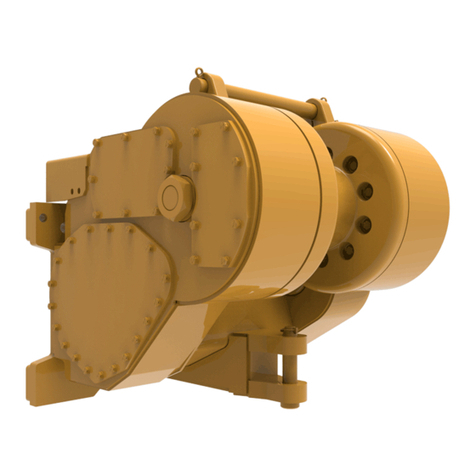
Allied Systems
Allied Systems W6G User manual
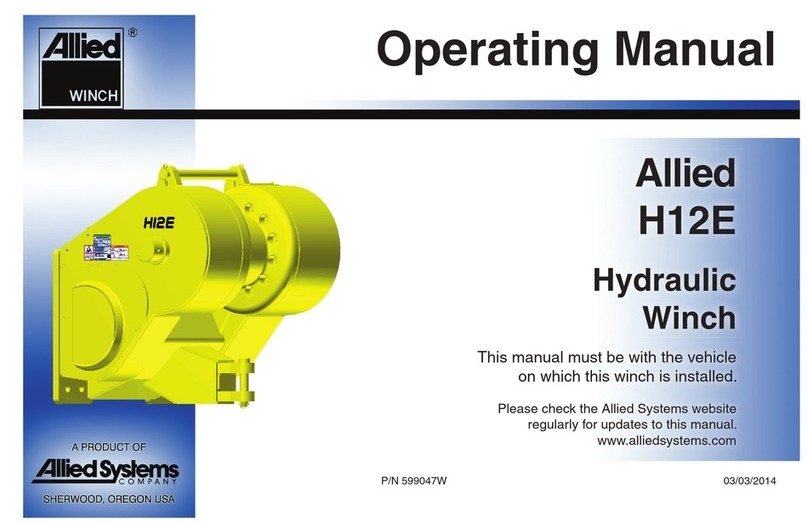
Allied Systems
Allied Systems H12E User manual
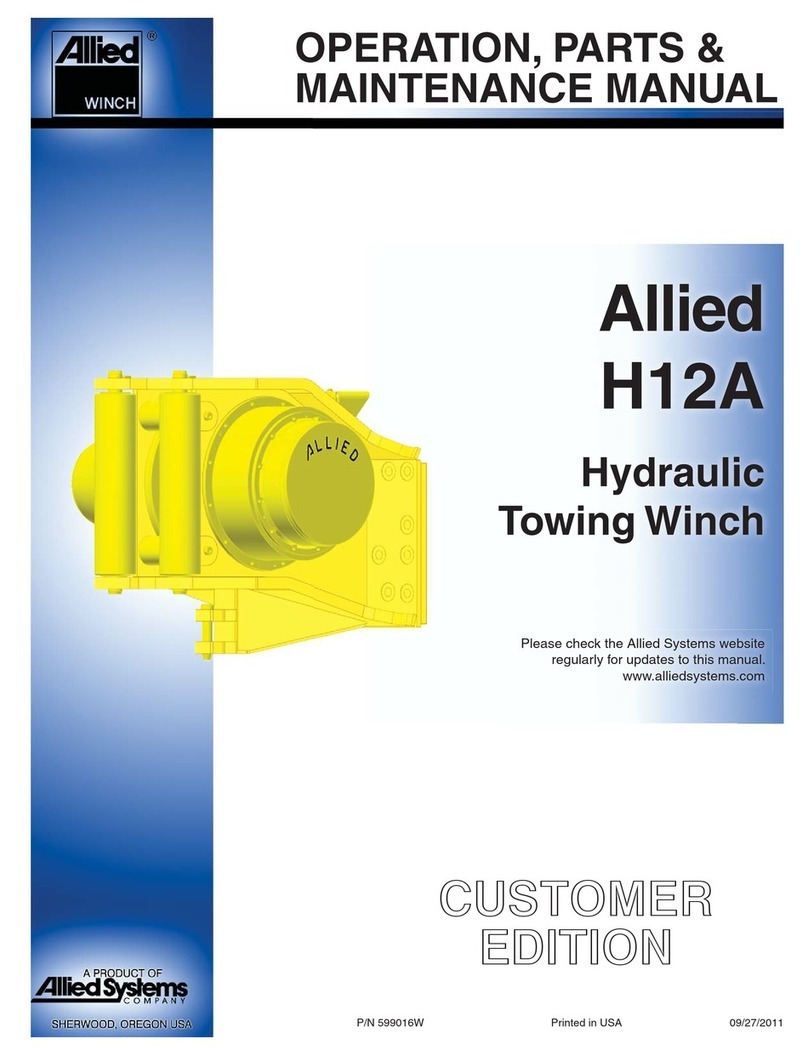
Allied Systems
Allied Systems H12A Guide
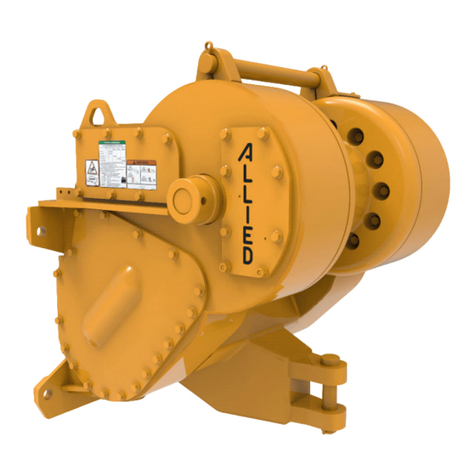
Allied Systems
Allied Systems W8L User manual

Allied Systems
Allied Systems W6F User manual
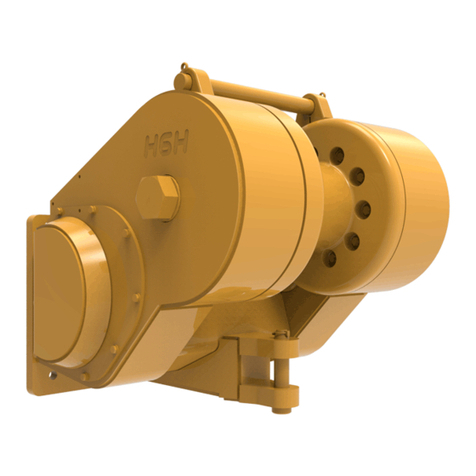
Allied Systems
Allied Systems H6H User manual

Allied Systems
Allied Systems W6G User manual

Allied Systems
Allied Systems H5C Series User manual

Allied Systems
Allied Systems W6G User manual
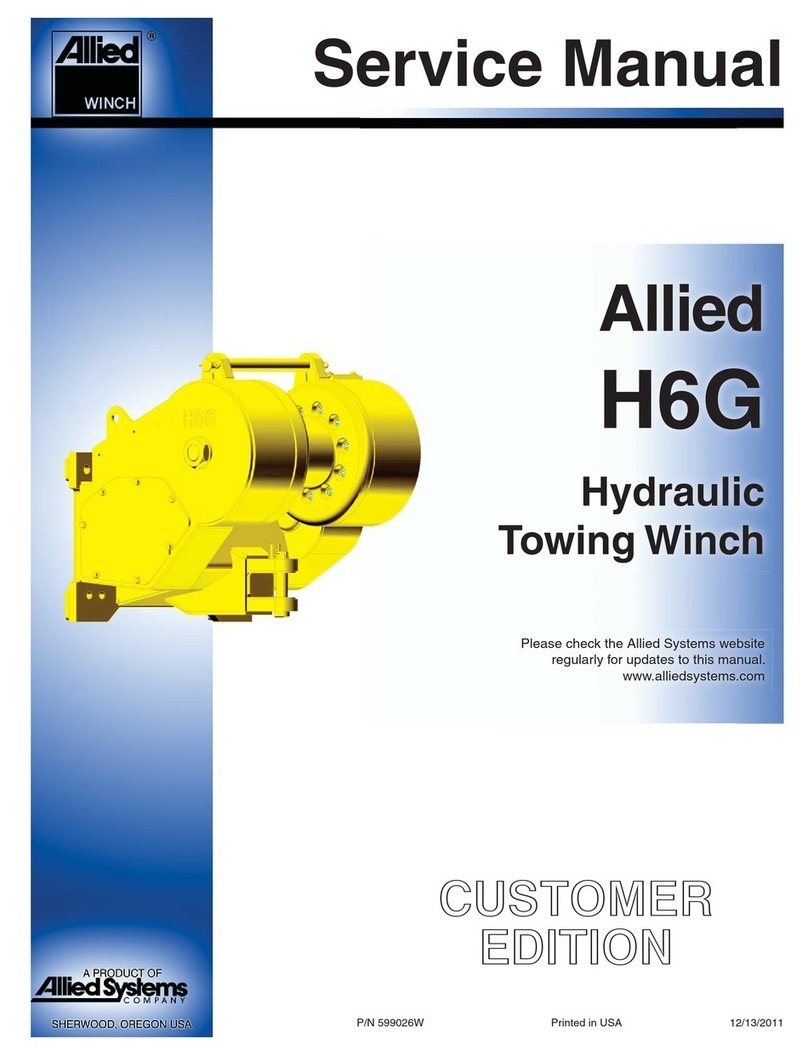
Allied Systems
Allied Systems Allied H6G Series User manual
